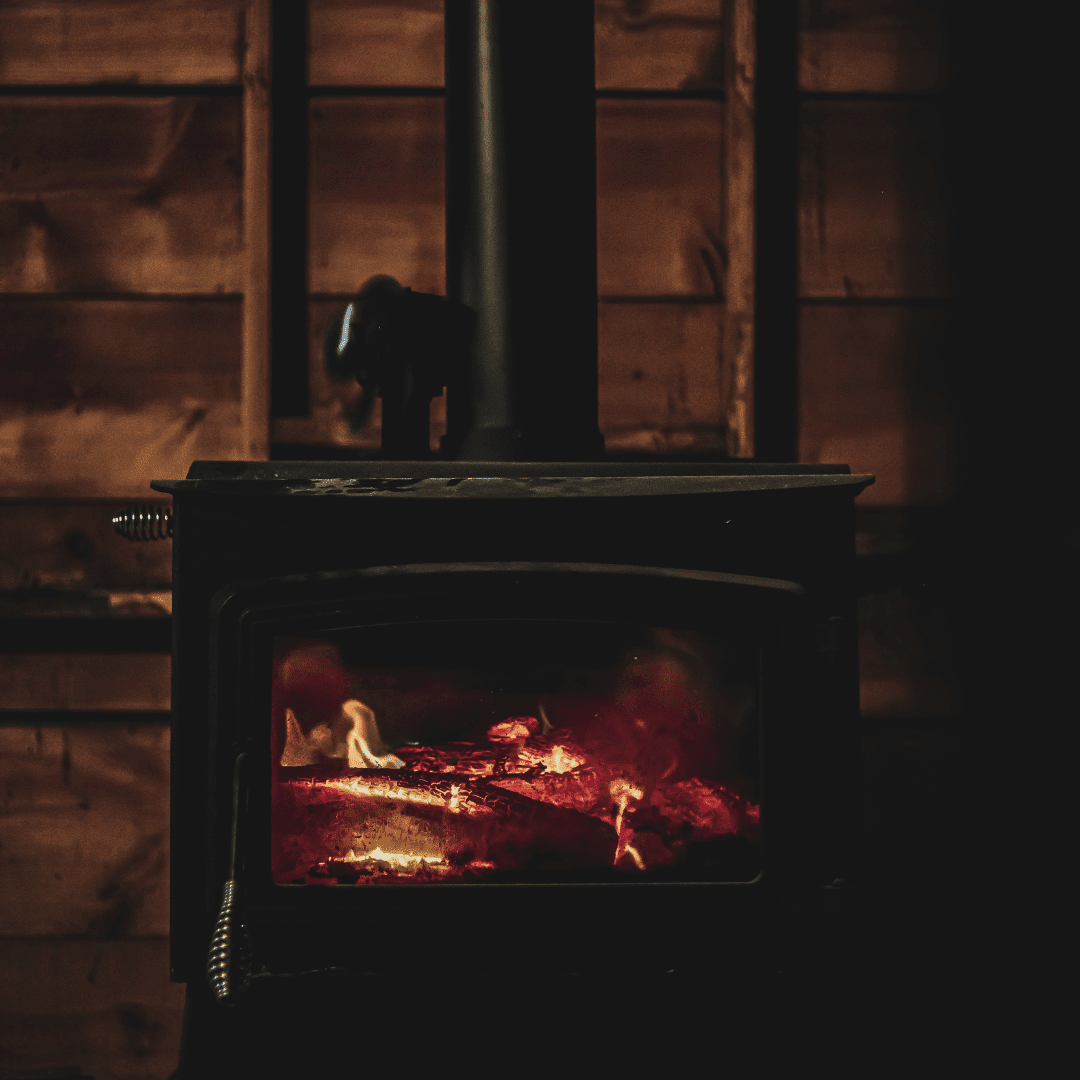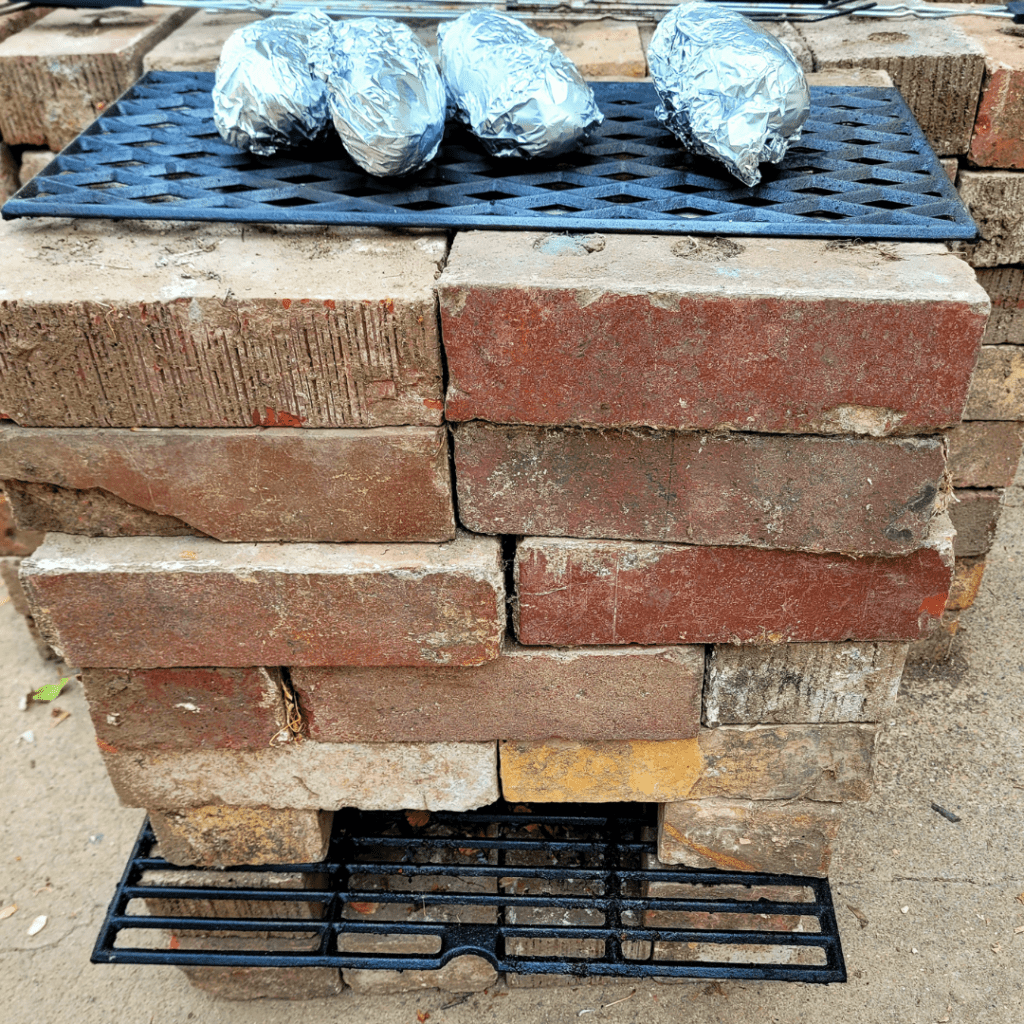Looking for the best wood-burning stoves for off-grid survival? In this guide, I share my top 5 prepper-approved wood stoves that deliver reliable heat when the power goes out. Whether you’re living off the grid full-time or prepping for emergencies, these stoves are efficient, long-lasting, and perfect for cooking and staying warm through the coldest nights. Discover what seasoned preppers really use—and why a good stove can make all the difference when it matters most!
Think about this, it is in the dead of winter. The weather keeps getting worse and colder. The weather channel just stated that a huge winter storm is coming in and power outages are likely. Don’t be caught in a winter power outage without a reliable off-grid heating source. Owning a wood-burning stove can help keep your home warm and help you heat food and boil water. Wood-burning stoves are powerful heating and cooking sources, and are easily obtainable and can be installed in any home.
Keep reading to learn more about why you should use a wood-burning stove.
This is a pinnable post. Tap or hover over any image in this post to pin to your Pinterest Boards.
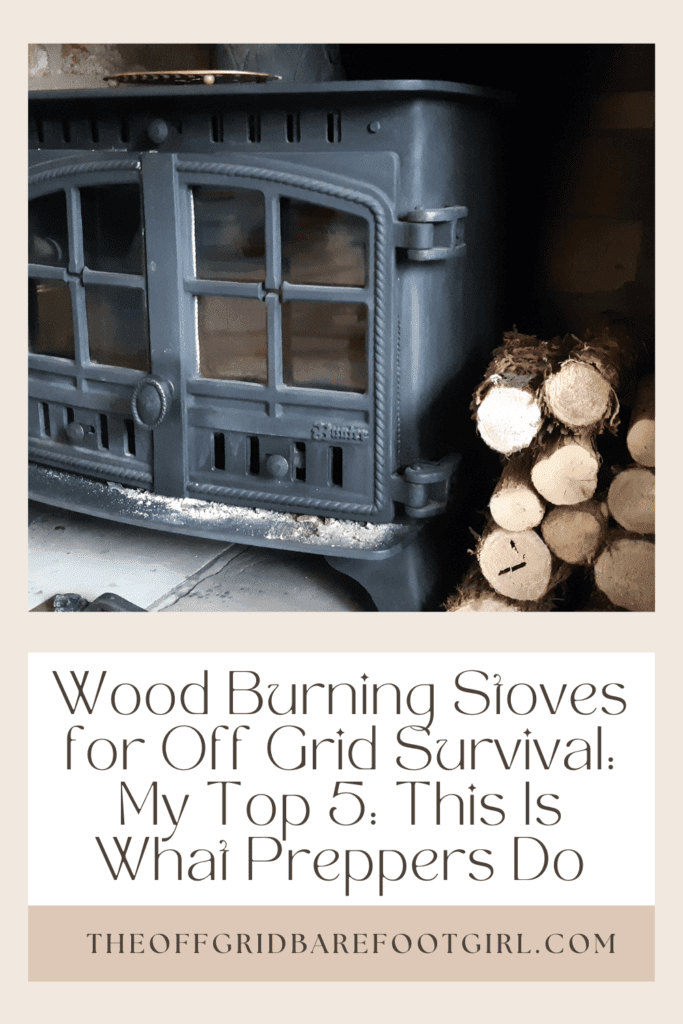
Jump to the Stoves
Introduction to Wood-Burning Stoves for Off-Grid Survival
Wood-burning stoves have been a reliable source of heat for centuries, and they continue to be an essential component of off-grid living and survival. When living off the grid, particularly in remote areas or during emergencies, having a dependable and efficient heating solution is crucial.
In this article, I will explore the benefits of wood-burning stoves in off-grid living, discuss how to choose the right stove for your needs, address safety considerations and best practices, provide guidance on proper installation and maintenance, explore alternative fuel options, and offer tips on maximizing efficiency and heat output. Whether you are a seasoned off-grid enthusiast or just starting your journey, understanding the importance and functionality of wood-burning stoves is essential for a comfortable and sustainable off-grid lifestyle.
The Importance of Heating in Off-Grid Living
When it comes to off-grid living, staying warm is pretty high on the priority list. Whether you’re living in a remote cabin or surviving a zombie apocalypse (hey, you never know), having a reliable source of heat is crucial. That’s where wood-burning stoves come in, my friends.
Overview of Wood-Burning Stoves
Picture this: a cozy cabin, crackling fire, and the comforting smell of burning wood. Wood-burning stoves have been around for centuries, and they’re still going strong. These bad boys are designed to efficiently burn wood, providing heat and a comforting ambiance in the process. Plus, they can even be used for cooking if you’re feeling culinary in your off-grid adventures.
Benefits of Wood-Burning Stoves in Off-Grid Living
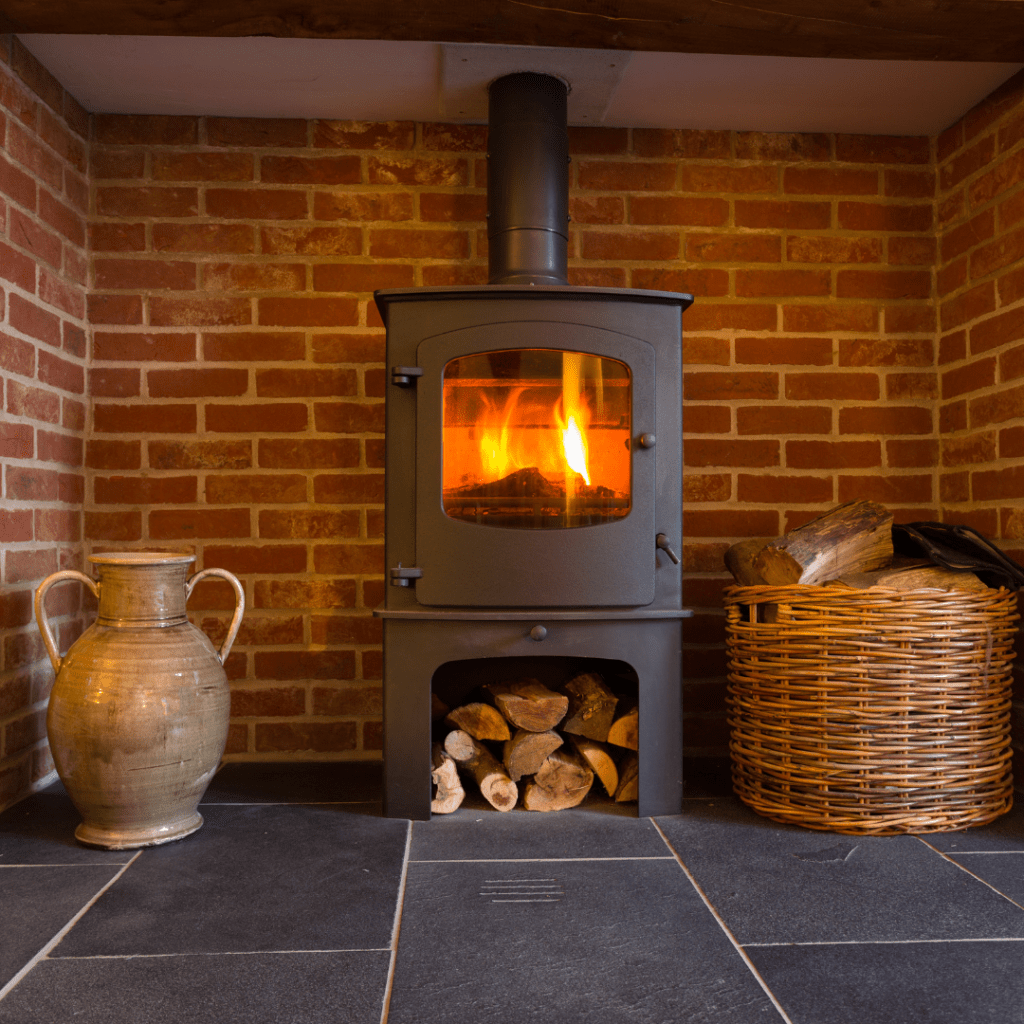
Energy Independence and Self-Sufficiency
Let’s face it, relying on the grid can be a bit dicey sometimes. But with a wood-burning stove, you can kiss those worries goodbye. Wood is a renewable resource, meaning you can gather it yourself and never have to deal with power outages or skyrocketing electricity bills. Talk about being the master of your own domain!
Cost Savings and Affordability
Money doesn’t grow on trees, but heating your home with wood certainly does. Wood-burning stoves are a cost-effective heating option, especially if you have access to free firewood. With soaring fuel prices, having a wood-burning stove can put a few extra bucks back in your pocket for the important things in life, like survival kit upgrades and emergency chocolate rations!
Environmental Sustainability and Reduced Carbon Footprint
Mother Nature will thank you for choosing a wood-burning stove. Unlike fossil fuels, wood is a renewable and carbon-neutral energy source. By utilizing wood as your heat source, you’re minimizing your carbon footprint and doing your part to keep this planet cozy and sustainable. Plus, you get to feel like a woodland lumberjack, and that’s just cool.
Choosing the Right Wood-Burning Stove for Off-Grid Survival
Factors to Consider When Selecting a Wood-Burning Stove
When it comes to choosing a wood-burning stove, there are a few things to keep in mind. Consider the size of your space, how much heat you need, and the type of wood you’ll be burning. You don’t want to end up with a stove that’s too small for your cabin or one that turns your living room into a sauna. It’s all about finding that perfect balance.
Different Types and Sizes of Wood-Burning Stoves
Wood-burning stoves come in all shapes and sizes, kind of like shoes. You’ve got the classic cast-iron stoves, modern freestanding stoves, and even compact stoves for tiny homes. Each type has its own charm and characteristics, so it’s essential to choose one that suits your style and needs. Just remember, Cinderella didn’t settle for a shoe that didn’t fit, and you shouldn’t settle for a stove that doesn’t fit your off-grid lifestyle.
Evaluating Efficiency and Heat Output Ratings
Efficiency is the name of the game when it comes to wood-burning stoves. You want to make sure your stove can efficiently convert wood into heat without wasting precious resources. Look for stoves with high heat output ratings and good efficiency percentages. After all, you don’t want to be throwing logs into the fire every five minutes like it’s a workout routine. Let the stove do the work, and you can focus on perfecting your s’mores recipe!
Safety Considerations and Best Practices for Wood-Burning Stoves
Proper Placement and Ventilation Requirements
Safety first, my friends. When installing a wood-burning stove, it’s crucial to follow proper placement and ventilation guidelines. Make sure your stove is placed on a non-combustible surface, away from flammable materials. Proper ventilation is also essential to avoid smoke and carbon monoxide buildup. You want to keep your lungs happy and avoid any unexpected bonfire situations.
Fire Prevention and Safety Precautions
Remember, we’re aiming for cozy, not catastrophe. Taking fire prevention and safety precautions is key when using a wood-burning stove. Keep flammable materials at a safe distance, use a fireproof hearth, and make sure you have a fire extinguisher nearby just in case. Oh, and always keep an eye on the stove when it’s burning—no one likes a runaway fire.
Understanding and Managing Carbon Monoxide Risks
We’re all about saving the planet, but carbon monoxide is a no-go. Wood-burning stoves produce carbon monoxide, so it’s important to have proper ventilation and install a carbon monoxide detector. Keep those windows cracked and ensure your living space is well-ventilated to avoid any unwelcome surprises. We want the warmth without the wooziness! I have written a helpful post on how to keep safe when it comes to detecting carbon monoxide in your home.
How to Survive the Silent Killer Carbon Monoxide Poisoning
Proper Installation and Maintenance of Wood-Burning Stoves
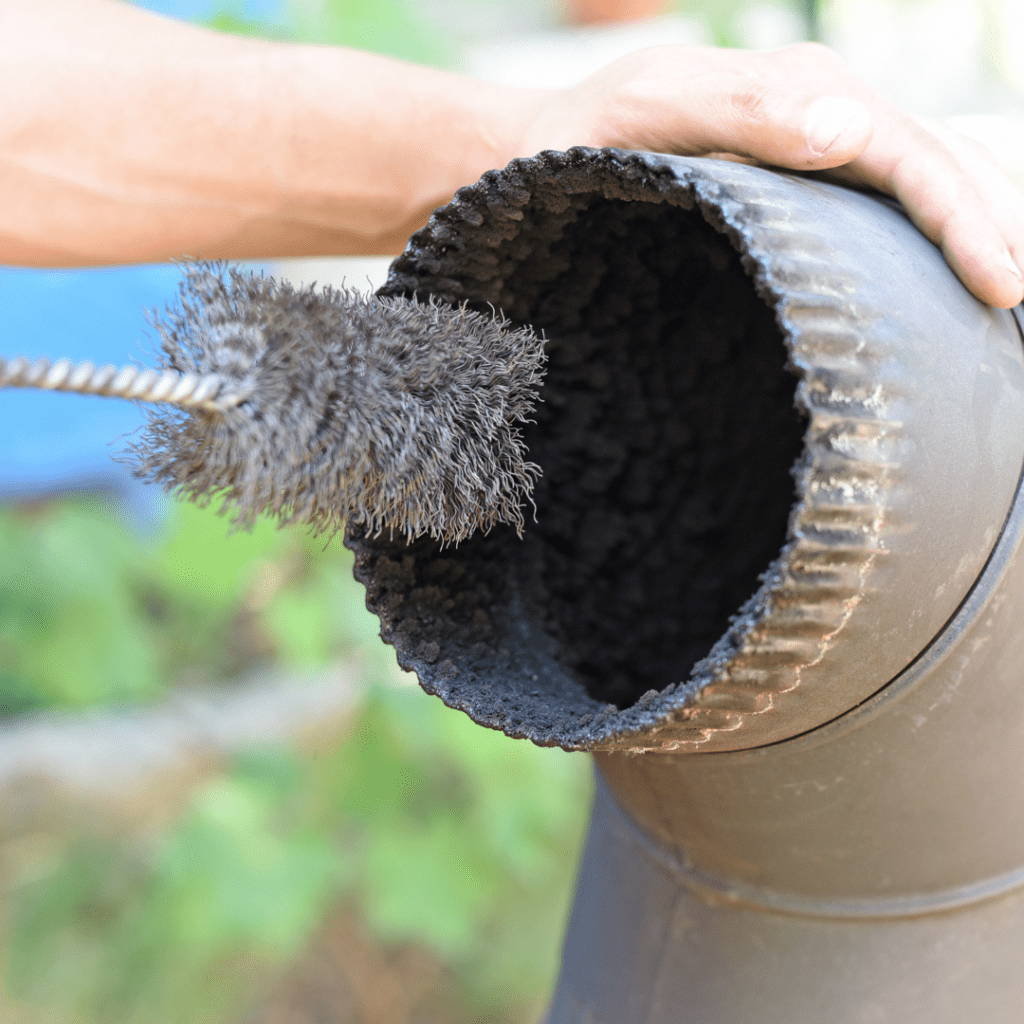
Installation Guidelines and Regulations
When it comes to installing your wood-burning stove for off-grid survival, it’s important to follow the guidelines and regulations to ensure safety and effectiveness. Trust me, you don’t want to be dealing with a crooked chimney or a stove that’s spitting sparks like it’s auditioning for a circus act.
Make sure to consult local building codes and regulations before you start. It may feel like a hassle, but it’s better to be safe than sorry. Plus, you don’t want to be on the wrong side of the law when it comes to fire safety – it’s not a good look.
Routine Cleaning and Maintenance Tasks
Just like your significant other, your wood-burning stove needs a little love and attention every now and then. Regular cleaning and maintenance are essential for keeping your stove in tip-top shape.
Think of it as a spa day for your stove. Give it a good scrub and remove any soot or creosote buildup. Trust me, nobody wants a chimney fire as part of their off-grid survival experience. Plus, a clean stove will give you better performance and efficiency. It’s a win-win!
Troubleshooting Common Issues
Sometimes, even the best wood-burning stoves can have a bad day. I’m here to help you troubleshoot those pesky common issues.
From smoke leaking into your room to difficulty getting your fire started, I’ve got you covered. I’ll share some tricks and tips to get your stove back on track and keep you warm in the wilderness. After all, off-grid survival doesn’t have to mean freezing your buns off.
First and foremost, if you’re having trouble getting a fire started, make sure the damper is open and there’s enough airflow. You might also want to check the kindling and ensure it’s dry enough to ignite. If you’re experiencing weak flames or low heat output, clean out any ash or soot buildup from both the stovepipe and the chimney. Remember that proper maintenance is key!
And speaking of maintenance, if your stove is emitting smoke into your home rather than up the chimney where it belongs, it’s likely due to a blocked or dirty chimney. Get yourself a chimney brush and give it a thorough cleaning – problem solved! Just remember to be cautious when dealing with fire, and always consult an expert if in doubt.
Alternative Fuel Options for Wood-Burning Stoves in Off-Grid Living
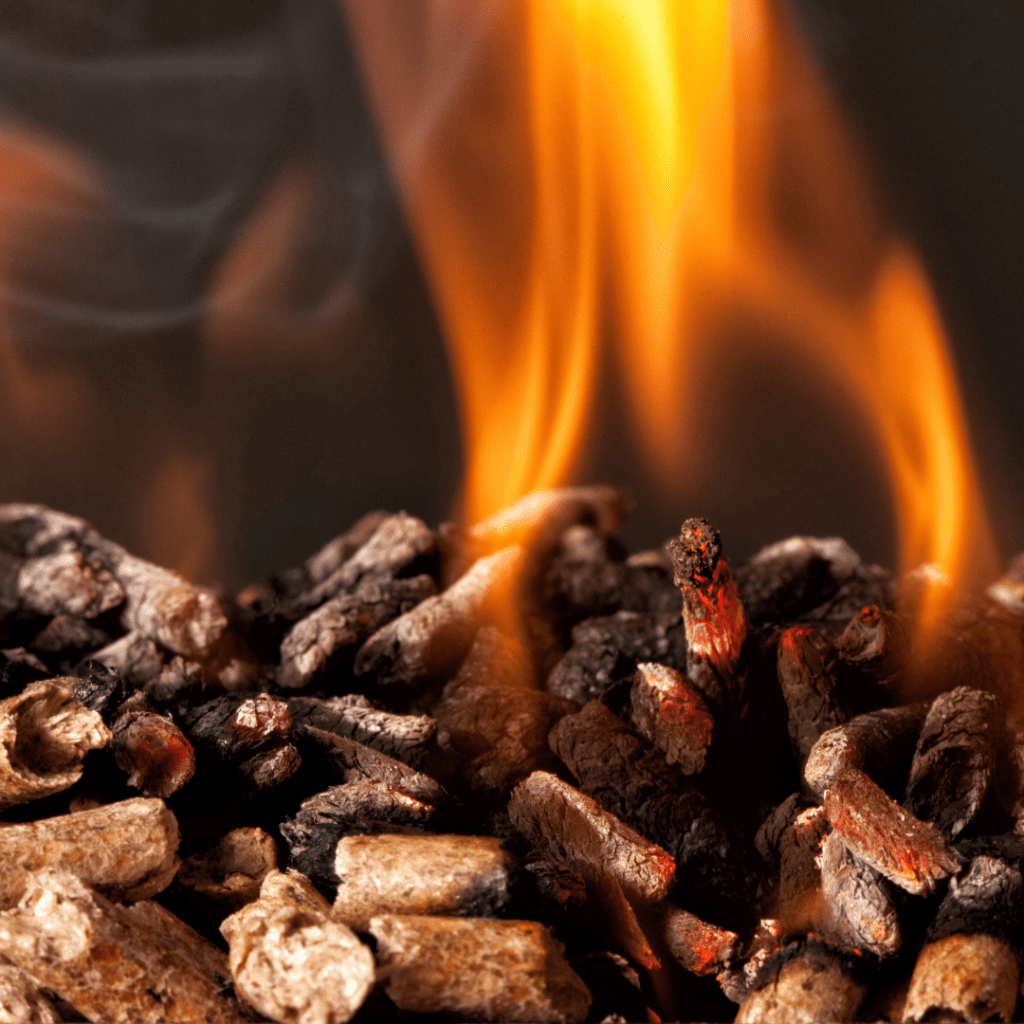
Exploring Different Types of Wood Fuels
Wood is the classic go-to fuel for wood-burning stoves, but did you know there are different types of wood that can affect your burning experience? From dense hardwoods to resin-rich softwoods, each has its own burning characteristics.
I’ll break down the pros and cons of different wood types, so you can make informed decisions about which ones to use when you’re off the grid and in need of some serious heat.
When it comes to choosing the right wood for your wood-burning stove, there are several factors to consider.
- Hardwoods: Hardwoods like oak and maple are popular choices due to their long burning times and high energy output. They also tend to produce less smoke and emit a pleasant aroma when burned.
- Softwoods: On the other hand, softwoods like pine and cedar ignite quickly, but burn faster, requiring more frequent refueling. Softwoods can also produce more creosote buildup in your chimney, increasing the risk of a fire hazard.
Additionally, certain woods, such as apple or cherry, offer unique flavors that can enhance the taste of food grilled on your stove. However, it’s important to note that not all woods are suitable for indoor burning, as some can release harmful toxins when burned at higher temperatures. So, while hardwoods provide great heat output and efficiency, it’s crucial to be aware of potential drawbacks like increased costs and maintenance associated with using them in your wood-burning stove.
Considerations for Using Wood Pellets or Other Biomass Fuels
Looking for alternative options to wood? Wood pellets and other biomass fuels might be the answer. These compact little powerhouses can give you a longer burn time and can be easier to handle than logs.
If you’re a fan of cozy evenings by the fire but worry about the environmental impact of your wood-burning stove, consider exploring alternative fuel sources.
- Pellets: One option is pellets made from compressed sawdust or agricultural waste. These small, cylindrical pieces burn efficiently and produce minimal smoke, making them an environmentally friendly choice.
- Bioethanol: Another alternative is using bioethanol as fuel, which is derived from organic materials such as corn or sugarcane. Bioethanol burns clean without emitting harmful toxins or producing ash, offering a convenient and eco-conscious option for heating your space.
Additionally, utilizing natural gas inserts can significantly reduce pollutants emitted into the atmosphere compared to traditional wood stoves. So don’t let concerns over environmental consciousness put a damper on your cozy nights; choose alternative fuel sources that align with your sustainable values and enjoy guilt-free warmth by your wood-burning stove!
Availability and Sustainability of Alternative Fuel Sources
Sure, alternative fuel sources might sound great, but are they readily available when you’re off the grid? And are they sustainable in the long run?
I’ll dive into the availability and sustainability factors of different alternative fuel sources so you can make an informed choice. After all, sustainability is not just a trendy buzzword; it’s a way of life for off-grid survival enthusiasts like yourself.
Wood-burning stoves have been around for centuries, providing warmth and ambience to countless homes. While traditional wood fuel may seem like the only option, there are actually several alternative fuel sources available.
- Pellet Stoves: Pellet stoves, for example, use compressed sawdust pellets that burn efficiently and produce less creosote buildup.
- Ethanol Fireplaces: Ethanol fireplaces utilize bioethanol made from renewable sources like corn or sugarcane, offering a clean burn without the need for chimneys or vents.
- Briquettes: Additionally, some wood-burning stoves can be adapted to run on briquettes made from recycled coffee grounds or even discarded nut shells.
Embracing these different alternative fuel sources not only diversifies our options, but also contributes towards the sustainability efforts of our planet in a casual yet responsible manner.
Maximizing Efficiency and Heat Output of Wood-Burning Stoves
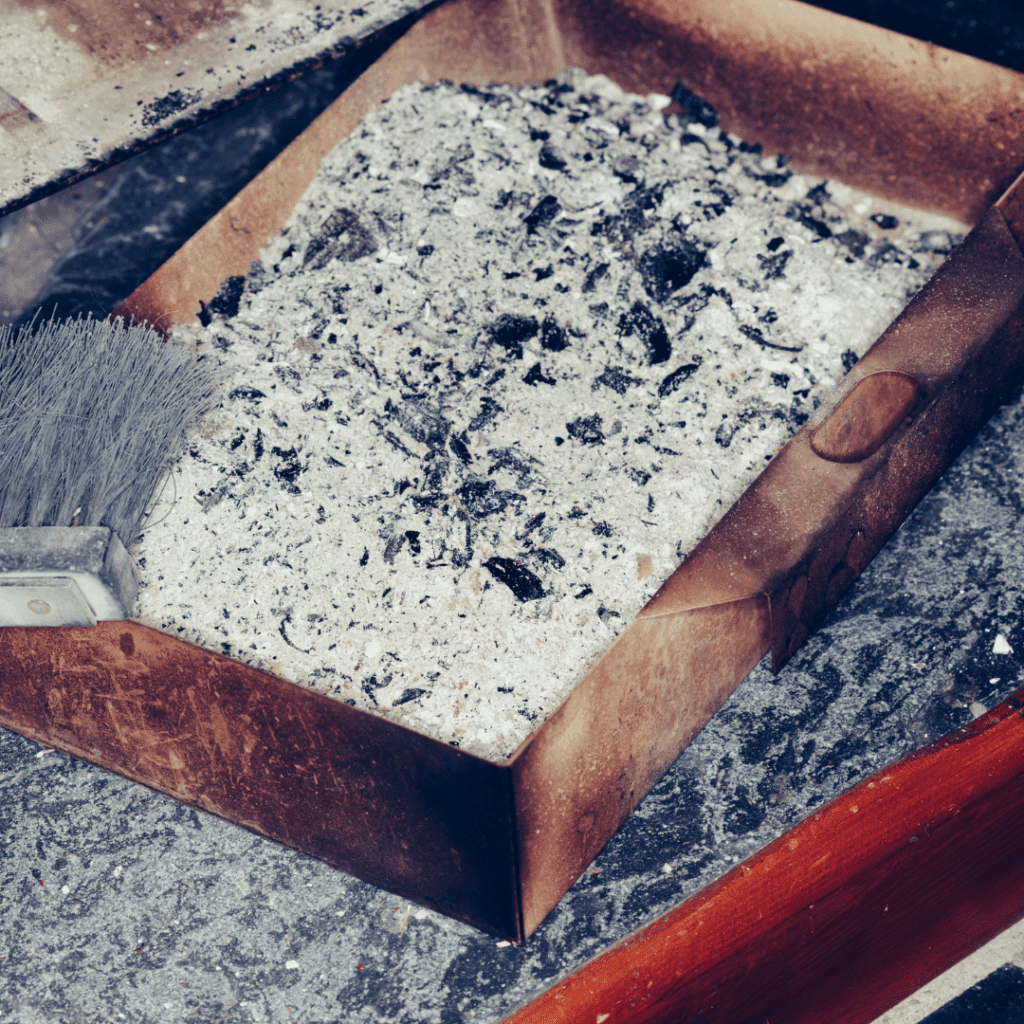
Tips for Effective Wood-Burning Techniques
Burning wood might seem like child’s play, but there’s an art to it, my friend. I’ll share some tried and tested tips to help you become a wood-burning maestro. From stacking the perfect firewood to getting the right airflow, these tips will ensure you’re getting the most out of your stove.
When it comes to mastering the art of wood-burning stove techniques, a few tips can make all the difference.
- Firstly, start off with dry and seasoned firewood as it produces more heat and reduces smoke buildup.
- Preparing a bed of ash at the bottom of the stove helps maintain good airflow and prevent coals from smothering.
- To ensure efficient burning, arrange logs in a crisscross pattern, allowing enough space for air circulation.
- Lighting the fire from the top rather than the bottom promotes cleaner combustion and minimizes creosote buildup on the chimney.
- Additionally, adjusting the dampers properly can control airflow and regulate heat output effectively.
- Regular cleaning of your stove is vital for peak performance, so remember to remove ash residues and other debris periodically.
Embracing these tips will not only maximize heating efficiency but also provide cozy warmth during those chilly winter nights in a fuss-free manner!
Proper Use of Dampers and Airflow Control
Dampers and airflow control might not sound like the sexiest topics, but trust me, they can make a real difference in the performance of your wood-burning stove. I’ll break it down for you in a way that won’t make your head spin.
You’ll learn how to master the art of damper adjustments and airflow control to maximize heat efficiency and keep your cabin cozy, even in the harshest winter storms.
Keeping an eye on the dampers and airflow is crucial for getting optimal heat from your stove while ensuring efficient burning and reducing smoke emissions.
- First things first, let’s talk about the primary damper. This bad boy is usually located near the top of the stovepipe or chimney, and it controls how much draft flows through the system. Opening it wide allows more air in, resulting in a hotter fire – perfect for those chilly winter nights! On the other hand, partially closing it slows down combustion, prolonging burn time.
- Next up is the secondary air intake damper found at the front or bottom of your stove, responsible for supplying oxygen to fuel gases that haven’t fully burned yet. By adjusting this one correctly, you can improve efficiency by ensuring complete combustion.
So fellow wood-stove enthusiasts, remember to give those dampers some love by tweaking them as needed to strike that perfect balance between warmth and conservation!
Utilizing Heat Exchange Systems and Thermal Storage
Why should all the heat from your wood-burning stove go to waste? Let’s put that heat to work, my friend! I’ll introduce you to some nifty heat exchange systems and thermal storage options that will not only make you feel like a genius, but also save you some serious bucks.
So, here’s the deal on heat exchange systems and thermal storage options for wood-burning stoves. These nifty inventions are designed to make your heating more efficient and environmentally friendly.
- Heat Exchange System: The heat exchange system, typically made of steel tubes or plates, captures the excess heat produced by your stove and transfers it to water or air. This warm fluid is then circulated around your home, providing a cozy atmosphere without wasting any energy.
- Thermal Storage Options: Thermal storage options take it up a notch by storing this captured heat in materials like bricks, stone, or water tanks. By slowly releasing the stored heat over time, these options ensure that your place stays warm even after the fire dies down. Plus, they reduce the need for constant refueling of your stove.
So whether you’re looking to save some bucks on heating bills or simply want to have a sustainable way to keep warm during those chilly winter nights, these systems and options are definitely worth considering.
Embracing Wood-Burning Stoves for Off-Grid Survival
Wood-burning stoves are like the superheroes of off-grid living. They provide warmth, comfort, and even a little bit of magic. With proper installation, maintenance, and a bit of know-how, you can harness their powers to keep you toasty and cozy in the wild.
So, embrace the wood-burning stove and let it be your trusty sidekick in your off-grid survival adventure. Because when it comes to staying warm and staying alive, it’s hard to beat the charm of a crackling fire and the satisfying smell of burning wood.
What I Want in a Wood-Burning Stove
As previously mentioned, using a wood-burning stove can help provide your home with a reliable heating source on the coldest of days. Keep a good supply of small dry logs to keep your wood-burning stove burning for hours.
Since heat rises, it is best to place the wood-burning stove in the basement or lower part of the home and direct the heat to the heating vents throughout the whole house. I grew up in Ohio around the Amish, and this is what I know they do with their wood-burning stoves.
When it comes to choosing the best wood-burning stoves for your home, there are a few different things we all look for, as I have mentioned above. For me, I want a wood-burning stove that provides a firebox that reveals the flickering flames so that my family and I can sit around and enjoy.
Furthermore, I also want to have a wood-burning stove that has a flat top that allows for heating and cooking. I want to be able to place my cast iron pans, Dutch Oven, or teapot on the top of the wood-burning stove to cook or boil water. I want my wood-burning stove to be able to have a small oven so that I can place a tray of herbs or fruit to dehydrate or possibly bake some bread.
Further, I also want a power-house wood-burning stove on the lower part of my home that blows hot heat throughout the vents in my home for all the rooms. Feeding one lower-level wood-burning stove that provides heat through the vents for all rooms is a very self-sufficient way to heat a large multi-level home.
Let’s take a look at what is on the market.
Top 5 Wood Burning Stoves on Amazon (Based on Reviews)
1. US Stove 900 Sq. Ft. Cast Iron Wood Stove
- Rating: 3.8/5 (367 reviews)
- Highlights: Affordable, compact, and efficient for small spaces.
- Ideal for: Cabins, tiny homes, and emergency heating.
2. Cubic Mini Wood Stove – CB-1000-BL
- Rating: 4.8/5 (98 reviews)
- Highlights: Designed for tiny homes, RVs, and boats; compact yet powerful.
- Ideal for: Small off-grid living spaces.
3. Camp Chef Alpine Heavy Duty Cylinder System
- Rating: 4.0/5 (7 reviews)
- Highlights: Portable and versatile, suitable for camping and wall tents.
- Ideal for: Outdoor cooking and heating in temporary shelters.
4. Winnerwell Nomad Large Wood Burning Stove
- Rating: 4.9/5 (71 reviews)
- Highlights: Durable stainless steel construction; ideal for tent camping.
- Ideal for: Extended camping trips and off-grid adventures.
5. FlameCube™ Ultra-Compact Wood-Burning Camping Stove
- Rating: Not specified
- Highlights: Features a thermoelectric generator for USB charging; foldable design.
- Ideal for: Backpacking and emergency preparedness.
Comparison Table
| Stove Model | Price | Rating | Best For |
|---|---|---|---|
| US Stove 900 Sq. Ft. Cast Iron Wood Stove | $273.58 | 3.8/5 | Small spaces, cabins |
| Cubic Mini Wood Stove – CB-1000-BL | $487.00 | 4.8/5 | Tiny homes, RVs |
| Camp Chef Alpine Heavy Duty Cylinder System | $279.00 | 4.0/5 | Camping, wall tents |
| Winnerwell Nomad Large Wood Burning Stove | $439.99 | 4.9/5 | Tent camping, off-grid adventures |
| FlameCube™ Ultra-Compact Wood-Burning Camping Stove | $169.95 | Not specified | Backpacking, emergency preparedness |
Conclusion
Choosing the right wood-burning stove depends on your specific needs:
- For small spaces: The US Stove 900 Sq. Ft. Cast Iron Wood Stove offers affordability and efficiency.
- For tiny homes or RVs: The Cubic Mini Wood Stove – CB-1000-BL is compact and powerful.
- For outdoor cooking and temporary shelters: The Camp Chef Alpine Heavy Duty Cylinder System provides versatility.
- For extended camping trips: The Winnerwell Nomad Large Wood Burning Stove ensures durability and performance.
- For backpacking and emergencies: The FlameCube™ Ultra-Compact Wood-Burning Camping Stove is lightweight and includes a USB charger.Better Homes & Gardens+5Amazon+5The Spruce+5Alibaba+1Amazon+1Real Simple
Consider your space, intended use, and budget when selecting the best stove for your off-grid needs.
Wood-burning stoves are a cornerstone of off-grid survival—learn how to make the most of them in How to Live on Raw Land.
Learn how to make your home safe, warm, and self-sufficient during emergencies by checking out The Complete Guide to Emergency Preparedness: Everything You Need to Thrive in Any Situation.
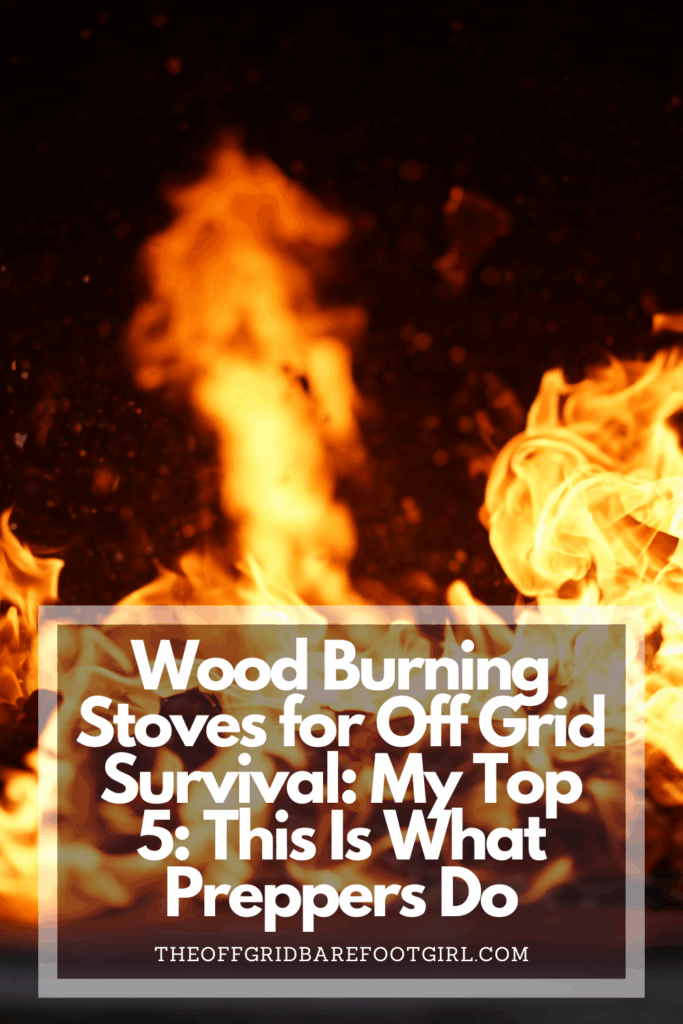
Frequently Asked Questions
1. Are wood-burning stoves safe for off-grid living?
Wood-burning stoves can be safe for off-grid living if proper safety precautions are followed. Ensuring proper installation, adequate ventilation, and regular maintenance are essential for safe operation. It is also important to have carbon monoxide detectors and fire extinguishers in place for added safety.
2. How do I choose the right size wood-burning stove for my off-grid home?
Choosing the right size wood-burning stove depends on factors such as the square footage of your living space, insulation levels, and climate conditions. A reputable stove dealer or professional can help you determine the appropriate size based on these factors to ensure optimal heat output and efficiency.
3. Can I use wood pellets or other alternative fuels in a wood-burning stove?
Many wood-burning stoves are designed to burn wood pellets or other biomass fuels in addition to traditional firewood. However, it is crucial to check the manufacturer’s guidelines and make sure your stove is compatible with these fuels. Proper handling, storage, and availability of alternative fuels should also be considered for off-grid living.
4. How can I maximize the efficiency of my wood-burning stove?
To maximize the efficiency of a wood-burning stove, it is important to use proper burning techniques, such as ensuring proper airflow and utilizing dampers effectively. Additionally, using dry and seasoned firewood, employing heat exchange systems, and utilizing thermal storage can all contribute to increased efficiency and heat output.
And there you have it, your guide to wood-burning stoves for off-grid survival. Stay warm, stay safe, and remember: firewood is your new best friend.
Summary
I hope I have inspired you to live sustainably with these tips and products.
If you were encouraged by this post, I invite you to check out my FREE Printables Page for fun free printables, planners, and charts.
ENTER MY FREE Printables Page HERE
Here are some more of my gardening inspiration posts to check out!
Magical Ways to Use Fairy Lights in Your Off-Grid Home
How to Live a Cozy Off-Grid Life
The Best Off-Grid Kitchen Tools for Indoors (No Power Needed!)
DIY Solar Made Simple: How I Powered My Off-Grid Life with Practical Preppers!
Sleeper Cells in America: What You Need to Know Now!
How People Are Surviving in Broken Cities with Broken Systems
When the World Hurts, We Prepare with Purpose
How to Live On Raw Land: Everything You Need to Know!
How to Do Off-Grid Laundry with Eco-Friendly Laundry Detergent!
Hollywood on Fire! What Secrets Are In the Ashes?
FEMA Concentration Camps? Are Echos of the Past Returning?
How Likely Is a Russian EMP? One Pulse Could Black Us Out!
What Dark Secrets Lie in The Bird Flu Symptoms?
The Blackout Sun: Who Is Blacking Out Our Sunlight?
How to Bug-In During a Deep Freeze!
‘FOGVID-24?’ What’s in the Mysterious Fog That’s Making Everyone Sick?
From Snow to Sow: Plan Your Spring Garden Now!
11 Fun Ways to Brighten Your Spring Garden with Personality
Top 10 Spring Garden Crops to Harvest in 30 Days and Eat Now!
The Best Survival Crops for Caloric Survival
More Posts!
My Victory Garden: What I Learned from 5+ Years
Why Every Family Should Have a Victory Garden in Their Backyard Now!
The Best Perennials for a Long-Term Survival Garden
The Best Essential Oils for Plants That Repel Garden Bugs
How to Grow Green Garden Peas: Perfect Plump Peas!
Hugelkultur: Does This Epic Pioneering Method Actually Work?
9 Ways to Celebrate Earthing Day in Your Garden!
Gardening Indoors: Secrets of Growing Your Food Inside!
How to DIY a Milk Jug Drip Irrigation System!
Why Cedar Mulch Is The Perfect Natural Weed Barrier
Gardening Projects
Onions: How to Grow Onions for Storage
Peas: How to Grow Garden Peas for a Bumper Crop
Carrots: How to Grow Carrots for a Bountiful Harvest
Prep Your Garden for Spring Planting with These Expert Tips!
How to Grow a Prepper Garden to Survive and Thrive
The Best Garden Tools You Need for a Productive Season
Fastest Growing Vegetables for Your Survival Garden
How to Grow Marigolds As Pest Control In Your Vegetable Garden
Must-Have Tools for a Successful Balcony Vegetable Garden
How to Effectively Combat Powdery Mildew in Your Garden
The Best Tips for Organic Gardening
How to Release Ladybugs In Your Garden for Organic Pest Control
More Posts!!
The Best Garden Snail Control Strategies
The Best Spring Vegetables to Grow in Your Garden
Seed Starter Mix: How To Make Your Organic Seed Starter Mix At Home
How to Grow a Productive Canning Garden
How to Plant and Grow a Salsa Garden
Easiest Heirloom Vegetable Seeds to Grow Now
How to Use the Hand Twist Claw Tiller: Tackling Tough Soil
More Fun Gardening Posts to Check Out!
Planning Your Garden: How to Plan a Vegetable Garden: Expert Green Thumb Tips!
Winterizing the Garden: How to Winterize Your Vegetable Garden: Step-by-Step Checklist
Mulching the Garden: How to Make Leaf Litter Mulch
Grow a Pumpkin Patch: How to Grow a Pumpkin Patch in Your Backyard
How to Grow a Fall Garden: 9 Best Fall Crops
Clever Ways to Incorporate Indoor Composting into Your Home
How to Start Composting for the Garden: A Step-by-Step Guide
The Ultimate Guide to Composting in Your Suburban Backyard
Why I Built A Survival Garden in My Backyard
16 Best Medicinal Herbs to Grow in Your Garden Now
Blessings,
The Off Grid Barefoot Girl

